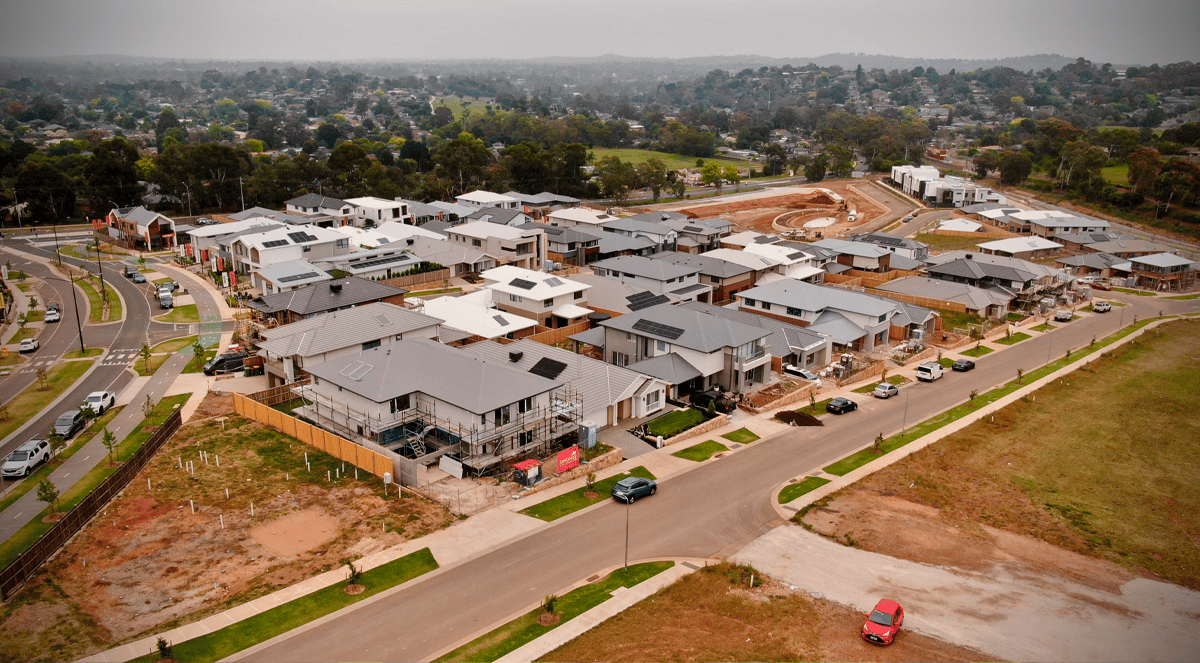%20(1).png)
This week, I was asked to appear on the Nine Network’s “Today” show to talk about easy strategies Aussies can use to take years of repayments off their home loans.
I also told Karl Stefanovic and Sarah Abo about mortgage traps to avoid.
It’s obviously hard to go through a lot of detail in a short interview on national television, so here I have broken down the information I shared and included some extra tips.
.png?width=1159&height=639&name=BodyImage%20(3).png)
Being smart with your biggest liability
A mortgage is probably the biggest financial commitment most Australians will ever undertake - a 25-30-year agreement with a bank to pay off your home.
If you take out a typical $750,000 standard variable home loan today with Australia’s biggest lender - the Commonwealth Bank, over the next 30 years, you stand to pay the bank back $1,669,467.
That’s the original sum of $750,000 plus a whopping $919,467 in interest.
Now, as it’s a variable loan, the actual amount of interest paid will vary as interest rates rise and fall.
But let’s say for this example that the CBA’s standard variable rate remains at the current 6.29% (BTW, any broker worth their salt should be able to get you a better interest rate than this….).
So, how do we reduce that huge interest bill of $919,467 and pay back that original $750,000 faster?
The answer is by being smart with our biggest liability and not leaving things on “set and forget”.
- Make Regular Extra Repayments
Paying just a bit more each month can dramatically cut your interest bill and your loan term.
Using that example of a $750,000 loan with the CBA …by making an additional repayment of $100 a month, you could potentially save a huge $64,678 in interest and shave 1 year and 9 months off your 30-year loan term.
An extra $200 a month would see total repayments reduced to $1,549,795 and your loan term reduced by 3 years and 3 months.
Sure, the cost of living is high, and it’s not always easy making ends meet, but if you put aside the price of a cup of coffee every weekday, by the end of each month, you’ll have an easy extra $100 to put into your mortgage.
- Shift to Weekly or Fortnightly Payments
As interest on your home loan is calculated daily, increasing the frequency of your repayments lowers your outstanding balance faster.
With our $750,000 loan example, the outstanding amount comes down to $1,666,114 if we pay weekly or $1,667,121 fortnightly.
But if we take the weekly option and make an extra payment of $25 a week (basically the equivalent of 5 coffees), our total repayment figure comes down to $1,596,656 - a saving of $72,811, and it also shortens the loan term by just under 2 years.
- Open a 100% Offset Account
An offset account lets your savings reduce the interest-bearing balance on a home loan.
With our $750,000 loan, if you kept $50,000 in an offset account and made monthly repayments, you would effectively only be paying interest on $700,000, reducing your total repayments by $61,297 over the life of the loan.
Now most people aren’t likely to leave a neat and tidy sum of $50,000 sitting in an offset account for 30 years.
They’d be likely to spend some of that money, invest it elsewhere or even use it to pay off some of the principal on their loan to reduce their debt position.
Nevertheless, there’s no getting away from the fact that Australians are some of the biggest users of offset account banking products in the world, using them to drastically reduce their home loan repayments.
It’s estimated that Australians currently have nearly $300 billion socked away in these accounts, a fact that’s helped them to take some of the sting out of the highest interest rate environment in a decade.
But as I explained to Karl and Sarah on “Today”, it's extremely important how you structure your use of offset accounts, as failure to do this properly means you could end up missing out on valuable interest deductions.
Most people structure their finances like this:
Money comes in from wages, salaries, and other sources and goes into a transaction account.
Once a month, after the bills are paid, a set amount is whacked into the offset account as a kind of savings pot.
That’s then raided for things like holidays and concert tickets.
What people should actually be doing is this:
Here, the offset becomes the account into which all wages go, plus any dividends or income from investments and any other incoming cash.
A pre-set, tightly budgeted amount is then taken out of the offset account each fortnight or month and transferred into a transaction account for all bills, expenses and spending money.
The remainder of the money in the offset is then regarded as “off-limits”, unless there’s an emergency.
This turns the offset account into what some people term a “master facility”.
Given that banks calculate interest daily on home loans and offset accounts, this set-up guarantees that the largest possible amount of money available to you on any given day is offsetting your mortgage.
If done right, this could save you hundreds of thousands of dollars over the life of your loan.
You’ll also pay less tax.
As the interest saved in a home loan offset account is not taxable, it can be more beneficial than earning interest in a savings account, which of course, you have to pay tax on.
- Use the Money Saved with an Offset Account to make Extra Repayments
Periodically, banks will send you a statement or display on your internet banking website or app how much money you’ve actually saved in mortgage interest by having an offset account.
If you are in a position to afford this, make that “saved” amount an extra repayment on your home loan.
- Use a Redraw Facility
This works in a similar way to an offset account.
A redraw facility on a home loan allows you to withdraw extra repayments you've made above the minimum required amount.
Essentially, if you've paid down your principal balance faster than scheduled, you can access those extra funds as needed.
This provides flexibility, potentially saving on interest, and allows you to access funds for various big expenses without taking out a new loan.
- Refinance With Your Existing Lender or Another Bank
This sounds obvious, but you’d be amazed how many people “set and forget” their largest liability.
As a result, they end up paying a “loyalty tax”.
At least once every 12 months, have a conversation with a mortgage broker about switching to a cheaper loan.
There will be costs involved in changing loans or lenders, but many of these are “one-offs” and any losses will soon be recouped by the savings made on a much lower interest rate.
And if you really want to cut down the years on your home loan, when you switch to a lower interest rate mortgage, continue to maintain your old repayment amount with your new lender.
- Put any Tax Refunds or Bonuses into Your Mortgage
If you receive an end-of-financial-year tax refund from the ATO or an annual bonus from work, consider using those lump sums to make larger repayments into your mortgage.
When Stage 3 tax cuts came into effect on the 1st of July 2024, some finance experts urged Australians who could afford it to put any tax savings straight into their mortgages, suggesting that for the average Australian household this move could shave two to three years off their home loans and save more than $75,000 in interest.
However, you need to be careful and check the fine print of your loan carefully. As Forbes.com reported recently, “Some home loans have certain rules related to additional repayments.
“You may only be able to contribute additional lump sum payments a certain number of times each year or to a set limit, and making these payments may come with a fee.”
- Maintain Repayments Through Rate Cuts
When interest rates drop, keep paying the old amount for faster principal reduction.
Remember that if you took out a home loan at the top of the recent interest rate cycle, APRA rules meant banks had to assess you as being able to comfortably repay your loan when an extra 3% was added to your interest rate.
If your circumstances have not materially changed since then, now that interest rates have fallen, you should be in a position to easily maintain that level of repayments.
Paying this extra amount as we head into a lower interest rate climate will knock hundreds of thousands of dollars off your home loan and dramatically shorten the life of your loan…by years.
- Get Rid of any other High-Interest Debts
If you still have any credit card debts or high-interest car loans, prioritise paying them off first before putting money into offset accounts or making extra repayments to reduce your mortgage.
If you have a redraw facility, it might even be worth taking a lump sum out of that account or seeing if you can roll that extra debt into your home loan.
Given most credit cards have interest rates of more than 20%, using money you have obtained in the 5.5% to 7% range to pay them off quickly makes a lot of sense.
- Be Your Own “Bank of Mum and Dad”
We often hear about the leg-up many Australians are getting into the property market from the so-called “Bank of Mum and Dad”.
You can run your own version of this to help reduce your mortgage.
If you have adult children who have jobs or parents who don’t have all their money tied up in investments, you can ask them to deposit any spare cash into your offset account instead of them putting these funds into high-interest accounts or term deposits.
However, you need to be extremely careful how this is done.
Make it clear this is essentially a commercial transaction, with you paying them a fair return on their investment.
They will have to declare any interest earned on their tax.
You will also need to keep meticulous records and with older people, you may need to check this will not impact their Centrelink benefits.
Here’s an example of how this could work:
You have a 19-year old child who studies at university and works part-time.
They’ve managed to scrape together $10,000, which they are going to be putting in the bank to earn some interest, as they are planning to head overseas next year.
At the moment the best rate going for a 12-month term deposit is around 4%.
You put this in your offset account for a year.
This will reduce the principal amount on which - in our mortgage example - we are paying off a $750,000 loan at 6.29%.
At the end of the 12 months, you repay your child their $10,000 and give them $400 in interest.
Over the past year, you will have saved a lot more than $400 on your mortgage by having that extra money in your offset account.
Why These Strategies Matter Now
With mortgage rates still higher than 5%, cutting a few years off a home loan not only saves serious money, it also eases long-term financial burden.
Combining multiple strategies, such as extra repayments, offsetting, refinancing, and maintaining repayment levels during interest cuts, can accelerate results dramatically.
But there’s a catch.
Some strategies aren't available to all homeowners:
For example, offset accounts may carry fees or not be offered on fixed-rate or construction loans.
Extra repayments during fixed terms might also incur break costs, so check your loan's fine print carefully.
But by adopting just a couple of the ten strategies I’ve outlined above, borrowers could realistically save years of interest payments—and emerge debt-free well ahead of schedule.
For households looking for financial freedom, proactive mortgage management remains one of the most powerful tools.
Stay Up to Date
with the Latest Australian Property News, Insights & Education.




.png?width=292&height=292&name=Copy%20Link%20(1).png)
 SIGN UP FOR FREE NEWSLETTER
SIGN UP FOR FREE NEWSLETTER





.jpg?width=1920&height=1080&name=Warning%2c%20You%20Might%20Be%20Facing%20Higher%20Taxes%20Soon%20(1).jpg)





.png?width=1920&height=1080&name=Rate%20Drops%20Signal%20BIGGEST%20Property%20Boom%20in%20DECADES%20(1).png)

.jpg?width=1920&height=1080&name=Labor%20vs%20Liberal%20These%20Housing%20Policies%20Could%20Change%20the%20Property%20Market%20Forever%20(1).jpg)
.jpg?width=1920&height=1080&name=QLD%20Slashes%20Stamp%20Duty%20Big%20News%20for%20Investors%20%26%20Home%20Buyers%20(1).jpg)
.jpg?width=1920&height=1080&name=Trump%20Just%20Slapped%20Tariffs%20%E2%80%93%20Here%E2%80%99s%20What%20It%20Means%20for%20Australia%20(1).jpg)
.jpg?width=1920&height=1080&name=Federal%20Budget%202025%20More%20Debt%2c%20No%20Housing%20%E2%80%93%20Here%E2%80%99s%20What%20You%20Need%20to%20Know%20(1).jpg)
.jpg?width=1920&height=1080&name=Australias%20Housing%20Crisis%20is%20about%20to%20get%20MUCH%20Worse%20(New%20Data%20Warns).jpg)
%20(1).jpg?width=1920&height=1080&name=Australias%20RENTAL%20CRISIS%20Hits%20ROCK%20BOTTOM!%20(2025%20Update)%20(1).jpg)
%20(1).png?width=1920&height=1080&name=Is%20Adelaide%20Still%20a%20Good%20Property%20Investment%20(2025%20UPDATE)%20(1).png)
.jpg?width=1920&height=1080&name=RBA%20Shocks%20with%20Rate%20Cuts!%20What%E2%80%99s%20Next%20for%20Property%20Investors%20(1).jpg)
%20(1).jpg?width=1920&height=1080&name=I%20Predict%20The%20Feb%20Rate%20Cut%20(My%20Price%20Growth%20Prediction)%20(1).jpg)
.png?width=1920&height=1080&name=Why%20Property%20Prices%20Will%20Rise%20in%202025%20Market%20Predictions%20(1).png)
.jpg?width=1920&height=1080&name=Why%20Investors%20Are%20Choosing%20Apartments%20Over%20Houses%202%20(1).jpg)
.jpg?width=1920&height=1080&name=Why%20Rate%20Cuts%20Will%20Trigger%20A%20Property%20Boom%20(1).jpg)
.jpg?width=1920&height=1080&name=Retire%20On%202Million%20With%20One%20Property%20(Using%20SMSF).jpg)
.jpg?width=1920&height=1080&name=4%20Reasons%20Why%20You%20Should%20Invest%20in%20Melbourne%20Now%20(1).jpg)
%20(1).jpg?width=1920&height=1080&name=Old%20Property%20vs%20New%20Property%20(Facts%20and%20Figures%20Revealed)%20(1).jpg)
%20(1).jpg?width=1920&height=1080&name=Will%20The%20New%20QLD%20Govt%20Create%20a%20Property%20Boom%20or%20Bust%20(My%20Prediction)%20(1).jpg)
%20Scott%20Kuru%20(1).jpg?width=1920&height=1080&name=Inflation%20Hits%20Three-Year%20Low%20(Will%20RBA%20Cut%20Rates%20Soon)%20Scott%20Kuru%20(1).jpg)
.jpg?width=1920&height=1080&name=How%20to%20Buy%20Investment%20Property%20Through%20SMSF_%20The%20Ultimate%20Guide%20(1).jpg)
.jpg?width=1920&height=1080&name=Victoria%20Slashes%20Stamp%20Duty%20Melbourne%20Set%20to%20Boom%20Scott%20Kuru%20(1).jpg)
.png?width=1571&height=861&name=Are%20Foreign%20Buyers%20Really%20Driving%20Up%20Australian%20Property%20Prices%20(1).png)
.jpg?width=1920&height=1080&name=The%20Single%20Factor%20That%20Predicts%20Property%20Growth%20Regions%20(1).jpg)
%20Scott%20Kuru%20(1).jpg?width=1920&height=1080&name=My%20Prediction%20On%20Rates%20%26%20Negative%20Gearing%20(Market%20Crash)%20Scott%20Kuru%20(1).jpg)

-1.png?width=1920&height=1080&name=Major%20Banks%20Cut%20Rates%20Will%20RBA%20Follow%20Suit%20(Sept%20Rate%20Update)-1.png)
%20Scott%20Kuru-1.png?width=1920&height=1080&name=Rate%20Cut%20Coming%20What%20New%20Zealands%20Move%20Means%20for%20Australia%20(Sept%20Prediction)%20Scott%20Kuru-1.png)
%20(1).jpg?width=1920&height=1080&name=Buy%20when%20the%20interest%20rates%20are%20high!%20(Why%20you%20must%20buy%20now!)%20(1).jpg)
.jpg?width=1920&height=1080&name=Carms_Revised%20Taxes%20Due%20Aug%209%20YT%20Thumbnail02%20(1).jpg)
.jpg?width=1920&height=1080&name=Carms_Too%20Little%20Too%20Late%20Aug%207%20YT%20Thumbnail01%20(1).jpg)









.jpg?width=1920&height=1080&name=Carms_Rate%20Drop%20In%20July%20Jun%2010%20YT%20Thumbnail02%20(1).jpg)
.jpg?width=1920&height=1080&name=Carms_Own%20a%20Property%20V6%20Jun%205_YT%20Thumbnail%20(1).jpg)









.png?width=1920&height=1080&name=Artboard%201%20(3).png)






.jpg?width=1920&height=1080&name=YT%20thumbnail%20%20(1).jpg)

